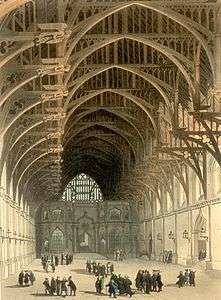Brutalist architecture
Brutalist architecture, or New Brutalism, is an architectural style which emerged during the 1950s in Great Britain, among the reconstruction projects of the post-war era.[1][2][3] Brutalist buildings are characterized by minimalist constructions that showcase the bare building materials and visible structural elements over decorative design.[4][5] The style commonly makes use of exposed concrete or brick, angular geometric shapes, and a predominantly monochrome color palette;[6][5] other materials, such as steel, timber, and glass, are also featured.[7]
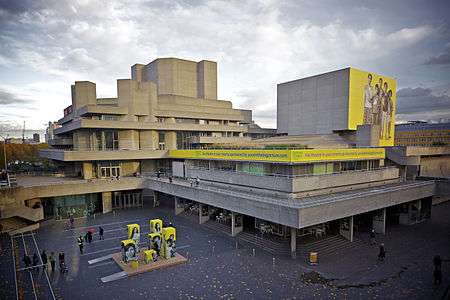
Descending from the modernist movement, Brutalism is said to be a reaction against the nostalgia of architecture in the 1940s.[8] Derived from the Swedish phrase nybrutalism, the term "New Brutalism" was first used by British architects Alison and Peter Smithson for their pioneering approach to design.[9][6][10] The style was further popularized in a 1955 essay by architectural critic Reyner Banham, who also associated the movement with the French phrases béton brut ("raw concrete") and art brut ("raw art").[11][12] The style, as developed by architects such as the Smithsons and Hungarian-born Ernő Goldfinger, was partly foreshadowed by the work of other architects such as French-Swiss Le Corbusier, Estonian-American Louis Kahn, and Finnish Alvar Aalto.[5][13]
In Great Britain, Brutalism was featured in the design of utilitarian, low-cost social housing influenced by socialist principles, and soon spread to other regions across the world, including Asia, North America, and the Soviet Bloc.[4][5][14] Brutalist designs became most commonly used in the design of institutional buildings, such as universities, libraries, courts, and city halls. The popularity of the movement began to decline in the late 1970s, with some associating the style with urban decay and totalitarianism.[5]
Brutalism has been polarising historically; specific buildings, as well as the movement as a whole, have drawn a range of criticism (often being described as "cold" or "soulless"), but have also elicited support from architects and local communities (with many brutalist buildings having become cultural icons, sometimes obtaining listed status).[15] In recent decades, the movement has become a subject of renewed interest.[15] In 2006, several Bostonian architects have called for a rebranding of the style to "Heroic architecture" to distance itself form the negative connotations of the term brutalism.[16]
History
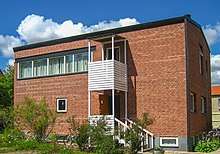
The term Nybrutalism (New Brutalism)[17] was coined by the Swedish architect Hans Asplund to describe Villa Göth, a modern brick home in Uppsala, designed in January 1950[9] by his contemporaries Bengt Edman and Lennart Holm.[10] Showcasing the 'as found' design approach that would later be at the core of Brutalism the house displays visible i-beams over windows, exposed brick inside and out, and poured concrete in several rooms where the tongue-and-groove pattern of the boards used to build the forms can be seen.[18][11] The term was picked up in the summer of 1950 by a group of visiting English architects, including Michael Ventris, Oliver Cox, and Graeme Shankland, where it apparently "spread like wildfire, and subsequently adopted by a certain faction of young British architects".[17][19][10]
The first published usage of the phrase "New Brutalism" occurred in 1953, when Alison Smithson used it to describe a plan for their unbuilt Soho house which appeared in the November issue of Architectural Design.[11][7] She further stated “It is our intention in this building to have the structure exposed entirely, without interior finishes wherever practicable."[10][11] The Smithsons' Hunstanton School completed in 1954 in Norfolk, and the Sugden House completed in 1955 in Watford, represent the earliest examples of New Brutalism in the United Kingdom.[20] Hunstanton school, likely inspired by Mies Van Der Rohe's 1946 Alumni Memorial Hall at the Illinois Institute of Technology in Chicago, USA, is notable as the first completed building in the world to carry the title of "New Brutalist" by its architects.[21][22] At the time, it was described as "the most truly modern building in England".[23]
The term gained increasingly wider recognition when British architectural historian Reyner Banham used it to identify both an ethic and aesthetic style, in his 1955 essay The New Brutalism. In the essay, Banham described Hunstanton and the Soho house as the "reference by which The New Brutalism in architecture may be defined."[11] Reyner Banham also associated the term New Brutalism with Art Brut and béton brut, meaning raw concrete in French, for the first time.[17][24][25] The best-known béton brut architecture is the proto-Brutalist work of the Swiss-French architect Le Corbusier, in particular his 1952 Unité d'habitation in France, the 1953 Secretariat Building (Palace of Assembly) in Chandigarh, India. and the 1955 church of Notre Dame du Haut in Ronchamp, France.
Banham further expanded his thoughts in the 1966 book, The New Brutalism: Ethic or Aesthetic?, to characterize a somewhat recently established cluster of architectural approaches, particularly in Europe.[26] In the book, Banham opined that Le Corbusier's concrete work was a source of inspiration and helped popularize the movement, suggesting "...if there is one single verbal formula that has made the concept of Brutalism admissible in most of the world's Western languages, it is that Le Corbusier himself described that concrete work as 'béton-brut'".[27] He further states that "..the words 'The New Brutalism' were already circulating, and had acquired some depth of meaning through things said and done, over and above the widely recognised connection with béton brut. The phrase still 'belonged' to the Smithsons, however, and it was their activities above all others that were giving distinctive qualities to the concept of Brutalism."[28]
Brutalism gained considerable momentum in the United Kingdom during the mid-twentieth century, as economically depressed (and World War II-ravaged) communities sought inexpensive construction and design methods for low-cost housing, shopping centres, and government buildings. Brutalism began to be favoured by governmental and institutional clients, with numerous examples in English-speaking countries (the United Kingdom, the United States, Canada, Australia), Western Europe (France, Germany, Italy), the Soviet Union, the Eastern Bloc (Slovakia, Bulgaria), and places as disparate as Japan, India, Brazil, the Philippines, and Israel. Brutalism became popular for educational buildings (especially university buildings) but was relatively rare for corporate projects, which largely preferred International Style. Brutalism became favoured for many government projects, rectangle tower blocks (high-rise housing), and shopping centres.
Combined with the socially progressive intentions behind Brutalist streets in the sky housing such as the Smithsons's Robin Hood Gardens, completed in 1972, Brutalism was promoted as a positive option for forward-moving, modern urban housing.
Characteristics
New Brutalism is not only an architectural style; it is also a philosophical approach to architectural design, a striving to create simple, honest, and functional buildings that accommodate their purpose, inhabitants, and location.[29][30] Stylistically, Brutalism is a strict, modernistic design language that has been said to be a reaction to the architecture of the 1940s, much of which was characterized by a retrospective nostalgia.[31]

Peter Smithson believed that the core of Brutalism was a reverence for materials, expressed honestly, stating "Brutalism is not concerned with the material as such but rather the quality of material,"[32] and "the seeing of materials for what they were: the woodness of the wood; the sandiness of sand."[33] Architect John Voelcker explained that the ‘New Brutalism’ in architecture ‘cannot be understood through stylistic analysis, although some day a comprehensible style might emerge’[34], supporting the Smithsons description of the movement as "an ethic, not an aesthetic".[35] Reyner Banham felt the phrase "the New Brutalism" existed as both an attitude toward design as well as a descriptive label for the architecture itself and that it "eludes precise description, while remaining a living force". He attempted to codify the movement in systematic language, insisting that a Brutalist structure must satisfy the following terms, "1, Formal legibility of plan; 2, clear exhibition of structure, and 3, valuation of materials for their inherent qualities ‘as found.’"[11] Also important was the aesthetic "image", or "coherence of the building as a visual entity".[11]
Brutalist buildings are usually constructed with reoccurring modular elements representing specific functional zones, distinctly articulated and grouped together into a unified whole. There is often an emphasis on graphic expressions in the external elevations and in the whole-site architectural plan in regard to the main functions and people-flows of the buildings.[36] Buildings may use materials such as concrete, brick, glass, steel, timber, rough-hewn stone, and gabions among others.[6] However, due to its low cost, raw concrete is often used and left to reveal the basic nature of its construction with rough surfaces featuring wood ‘shuttering’ produced when the forms were was cast in-situ.[6] Examples are frequently massive in character (even when not large) and challenge traditional notions of what a building should look like with focus given to interior spaces as much as exterior.[11][6]
A common theme in Brutalist designs is the exposure of the building's inner-workings—ranging from their structure and services to their human use—in the exterior of the building. In the Boston City Hall, designed in 1962, the strikingly different and projected portions of the building indicate the special nature of the rooms behind those walls, such as the mayor's office or the city council chambers. From another perspective, the design of the Hunstanton School included placing the facility's water tank, normally a hidden service feature, in a prominent, visible tower. Rather than being hidden in the walls, Hunstanton's water and electric utilities were delivered via readily visible pipes and conduits.[11]
Brutalism as an architectural philosophy was often associated with a socialist utopian ideology, which tended to be supported by its designers, especially by Alison and Peter Smithson, near the height of the style. Indeed, their work sought to emphasize functionality and to connect architecture with what they viewed as the realities of modern life.[29] Among their early contributions were 'streets in the sky' in which traffic and pedestrian circulation were rigorously separated, another theme popular in the 1960s.[36] This style had a strong position in the architecture of European communist countries from the mid-1960s to the late 1980s (Bulgaria, Czechoslovakia, East Germany, USSR, Yugoslavia).[37] In Czechoslovakia, Brutalism was presented as an attempt to create a "national" but also "modern socialist" architectural style. Such prefabricated Socialist era buildings are called panelaky.
Designers
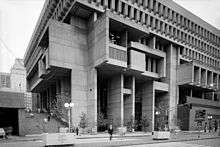
Architects whose work reflects certain aspects of the Brutalist style include Louis Kahn. Architectural historian William Jordy says that although Kahn was "[o]pposed to what he regarded as the muscular posturing of most Brutalism", some of his work "was surely informed by some of the same ideas that came to momentary focus in the Brutalist position."[38]
In Australia, examples of the Brutalist style are Robin Gibson's Queensland Art Gallery, Ken Woolley's Fisher Library at the University of Sydney (his State Office Block is another), the High Court of Australia by Colin Madigan in Canberra, and WTC Wharf (World Trade Centre in Melbourne).[39] John Andrews's government and institutional structures in Australia also exhibit the style.
Canada possesses numerous examples of Brutalist architecture. In the years leading to the 100th anniversary of the Confederation in 1967, the Federal Government financed the construction of many public buildings. Major Brutalist examples, not all built as part of the Canadian Centennial, include the Grand Théâtre de Québec, the Édifice Marie-Guyart (formerly Complex-G), Hôtel Le Concorde, and much of the Laval University campus in Quebec City; Habitat 67, Place Bonaventure, the Maison de Radio-Canada, and several metro stations on the Montreal Metro's Green Line; the Confederation Centre of the Arts in Charlottetown; the National Arts Center in Ottawa; the Hotel Dieu Hospital in Kingston; Robarts Library, Rochdale College in Toronto; the church of the Westminster Abbey in British Columbia.
In the United Kingdom, architects associated with the Brutalist style include Ernő Goldfinger, wife-and-husband pairing Alison and Peter Smithson, some of the work of Sir Basil Spence, the London County Council/Greater London Council Architects Department, Owen Luder, John Bancroft, and, arguably perhaps, Sir Denys Lasdun, Sir Leslie Martin, Sir James Stirling and James Gowan with their early works. Some well-known examples of Brutalist-influenced architecture in the British capital include the Barbican Centre (Chamberlin, Powell and Bon) and the National Theatre (Denys Lasdun).

In the United States, Paul Rudolph and Ralph Rapson were both noted Brutalists.[41] Evans Woollen III, a pacesetter among architects in the Midwest, is credited for introducing the Brutalist and Modernist architecture styles to Indianapolis, Indiana.[42] Walter Netsch is known for his Brutalist academic buildings. Marcel Breuer was known for his "soft" approach to the style, often using curves rather than corners. In Atlanta, Georgia, the architectural style was introduced to Buckhead's affluent Peachtree Road with the Ted Levy-designed Plaza Towers and Park Place on Peachtree condominiums. Many of the stations of the Washington Metro, particularly older stations, were constructed in the Brutalist style.
In Argentina, Clorindo Testa created the Bank of London and South America headquarters, one of the best examples of the 1950s.
In Italy, Vittoriano Viganò designed the Istituto Marchiondi in Milan in 1957,[43] and the BBPR studio built the Torre Velasca in 1958. More recent Modernists such as I. M. Pei, Gottfried Böhm and Tadao Ando also have designed notable Brutalist works. In Trieste, the main building of the Galileo Galilei high school (1969–71), as well as the residential housing complex known as "il Quadrilatero" (1969–82), in the district of Rozzol Melara are iconic representations of the brutalist style. Other examples include the Enrico Nordio art institute and the Temple of Monte Grisa. In Brazil, the style is associated with the Paulista School and is evident in the works of Pritzker Architecture Prize-winning architect Paulo Mendes da Rocha (2006).
In the Philippines, Leandro Locsin designed massive Brutalist structures, including the Tanghalang Pambansa and the Philippine International Convention Center.
In New Zealand, Sir Miles Warren and his practice Warren & Mahoney led the development of the so-called "Christchurch School" of architecture, which fused Brutalist architectural style with Scandinavian and Japanese values of straightforwardness. Warren's style has influenced New Zealand's public architecture.
In Serbia (then Yugoslavia), Božidar Janković was a representative of the so-called "Belgrade School of residence", identifiable by its functionalist relations on the basis of the flat[44][45] and elaborated in detail the architecture. Known example, Western City Gate also known as the Genex Tower is a 36-storey skyscraper in Belgrade, Serbia, which was designed in 1977 by Mihajlo Mitrović.[46] It is formed by two towers connected with a two-storey bridge and revolving restaurant at the top. It is 117 m (384 ft) tall[47] (with restaurant 135–140 m (443–459 ft)) and is the second-tallest high-rise in Belgrade after Ušće Tower. The building was designed in the brutalist style with some elements of structuralism and constructivism. It is considered a prime representative of the brutalist architecture in Serbia and one of the best of its style built in the 1960s and the 1970s in the world. The treatment of the form and details is slightly associating the building with postmodernism and is today one of the rare surviving representatives of this style's early period in Serbia. The artistic expression of the gate marked an entire era in Serbian architecture.[47]
On university campuses
In the late 1950s and early 1960s, many North American universities constructed campus buildings in the Brutalist style due to their low cost and ease of construction, beginning with Paul Rudolph's 1958 Yale Art and Architecture Building. Rudolph's design for the University of Massachusetts Dartmouth is an example of an entire campus designed in the Brutalist style. Walter Netsch designed the entire University of Illinois-Chicago Circle Campus (now the East Campus of the University of Illinois at Chicago) under a single, unified Brutalist design.[48] John M. Johansen and Evans Woollen III's Brutalist-style Clowes Memorial Hall, a performing arts facility that opened in 1963 on the campus of Butler University in Indianapolis, was praised for its bold and dramatic design.[49]
In 1964, Brigham Young University inaugurated the Franklin S. Harris Fine Arts Center, which features a largely Brutalist style of architecture. The University of Chicago's Joseph Regenstein Library, one of the largest libraries in the world, is designed in the Brutalist style. The Northwestern University Library is also designed in a Brutalist style and is a good example of this type of architecture. The University of Minnesota's West Bank campus features several Brutalist buildings, including the performing arts venue, Rarig Center, one of Ralph Rapson's most important works and the best example of Brutalism in the Twin Cities.[50] Brown University‘s two largest libraries and Graduate Center are significant brutalist works. The John D. Rockefeller Jr. Library and the Sciences Library (Brown University) were designed by Danforth Toan, whose firm also designed the Robarts Library at the University of Toronto.
The University of Louisville Belknap Campus has several Brutalist buildings, including the Bingham Humanities Building and the Interfaith Center. The Andrews Building at the University of Toronto Scarborough was built in a Brutalist architectural style and completed in 1964. In 1965, Desert Modern architect E. Stewart Williams was commissioned to design a new campus for the San Bernardino Community College District. Construction of Crafton Hills College began a year later, and the last building that was part of his original campus plan was completed in 1976. Williams' Brutalist design contrasts with the steep terrain of the area and was chosen in part because it provided a firebreak from the surrounding environment.[51] The Iowa State Center at Iowa State University originally consisted of five buildings in the Brutalist style, including a theater, auditorium, coliseum, stadium, and events center, as well as connecting elevated promenades. Eliot Hall, the remaining half of a pair of brutalist buildings built in 1972 on the campus of Washington University in St. Louis was demolished in 2012.[52]
At the same period in the U.K., similar expansion of higher education led to the construction of many Brutalist university buildings, notable examples being the Boyd Orr Building at the University of Glasgow, the University of Essex,[53] and Denys Lasdun's halls of residence at the University of East Anglia and Christ's College, Cambridge.[17] The exterior of the University of St Andrews's Andrew Melville Hall was used as the set for Dover Recovery Centre in the film Never Let Me Go.
Criticism and reception

Brutalism has some severe critics, including Charles, Prince of Wales, whose speeches and writings on architecture have excoriated Brutalism, calling many of the structures "piles of concrete". A 2014 article in The Economist noted its unpopularity with the public, observing that a campaign to demolish a building will usually be directed against a Brutalist one.[54] In 2005, the British TV program Demolition ran a public vote to select twelve buildings that ought to be demolished, and eight of those selected were Brutalist buildings.
One argument is that this criticism exists in part because concrete façades do not age well in damp, cloudy maritime climates such as those of northwestern Europe and New England. In these climates, the concrete becomes streaked with water stains and sometimes with moss and lichens, and rust stains from the steel reinforcing bars.[55]
Critics of the style find it unappealing due to its "cold" appearance, projecting an atmosphere of totalitarianism, as well as the association of the buildings with urban decay due to materials weathering poorly in certain climates and the surfaces being prone to vandalism by graffiti. Despite this, the style is appreciated by others, and preservation efforts are taking place in the United Kingdom.[25][56]
At the University of Oregon campus, outrage and vocal distaste for Brutalism led, in part, to the hiring of Christopher Alexander and the initiation of The Oregon Experiment in the late 1970s. This led to the development of Alexander's A Pattern Language and The Timeless Way of Building.[57]
Anthony Daniels, a British author, physician, and political commentator, has written for City Journal that Brutalist structures represent an artefact of European philosophical totalitarianism, a "spiritual, intellectual, and moral deformity." He called the buildings "cold-hearted", "inhuman", "hideous", and "monstrous". He stated that the reinforced concrete "does not age gracefully but instead crumbles, stains, and decays", which makes alternative building styles superior.[58]
Brutalism today
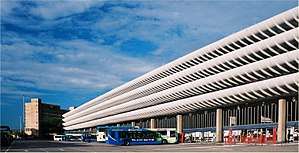
Although the Brutalist movement was largely over by the late 1970s and early 1980s, having largely given way to Structural Expressionism and Deconstructivism, it has experienced a resurgence of interest since 2015 with the publication of a variety of guides and books, including the Brutalist London Map (2015), This Brutal World (2016), SOS Brutalism: A Global Survey (2017) as well as the lavish Atlas of Brutalist Architecture (Phaidon, 2018).
Many of the defining aspects of the style have been softened in newer buildings, with concrete façades often being sandblasted to create a stone-like surface, covered in stucco, or composed of patterned, pre-cast elements. These elements are also found in renovations of older Brutalist buildings, such as the redevelopment of Sheffield's Park Hill. Cladding of the exterior may be undertaken in part to improve the neighbours' view, and cladding itself may bring fire risks; this is widely seen to be one of the causes of the 2017 Grenfell Tower fire.[59]
Villa Göth was listed as historically significant, due to its extreme architecture and "Brutalist" description inspiring a new building style, by the Uppsala county administrative board on March 3, 1995.[60] Several Brutalist buildings in the United Kingdom have been granted listed status as historic and others, such as the Pirelli Building in New Haven's Long Wharf,[61] and Gillespie, Kidd & Coia's St. Peter's Seminary, named by Prospect magazine's survey of architects as Scotland's greatest post-war building, have been the subject of conservation campaigns. The Twentieth Century Society has unsuccessfully campaigned against the demolition of British buildings such as the Tricorn Centre and Trinity Square multi-storey car park, but successfully in the case of Preston bus station garage, London's Hayward Gallery and others.
Notable buildings that have been demolished include the Smithson's Robin Hood Gardens (2017) in East London, John Madin's Birmingham Central Library (2016), Marcel Breuer's American Press Institute Building in Reston, Virginia, and Araldo Cossutta's Third Church of Christ, Scientist in Washington, D.C. (2014).
Notable buildings which are threatened include the Sirius building in Sydney and Atlanta Central Library in Atlanta, Georgia, USA. The Welbeck Street car park in London was demolished in October 2019.
Game developer Remedy Entertainment used the concept of Brutalism for the Oldest House in the 2019 paranormal/shooter video game Control.
Gallery
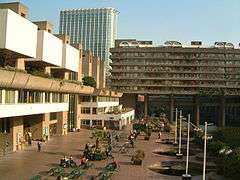 Barbican Center, London
Barbican Center, London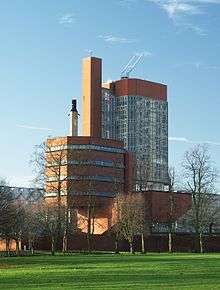 The Engineering Building (1959–1963) at the University of Leicester, England. Designed by James Stirling, it is Grade II* listed.
The Engineering Building (1959–1963) at the University of Leicester, England. Designed by James Stirling, it is Grade II* listed.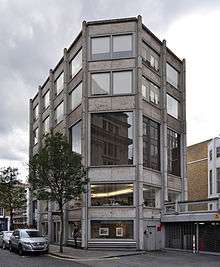 The Economist building (1959–1965) in Piccadily, London. Designed by the Smithsons.
The Economist building (1959–1965) in Piccadily, London. Designed by the Smithsons. Halls of residence at the University of East Anglia (completed 1966), designed by Denys Lasdun
Halls of residence at the University of East Anglia (completed 1966), designed by Denys Lasdun Alexandra Road Estate (1968) by Neave Brown, located in the London borough of Camden. In 1993, it was granted Grade II listed status, the first UK post-war council housing estate to be designated for preservation.[62]
Alexandra Road Estate (1968) by Neave Brown, located in the London borough of Camden. In 1993, it was granted Grade II listed status, the first UK post-war council housing estate to be designated for preservation.[62]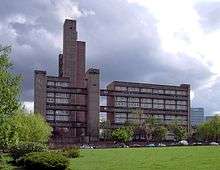 Carradale House (1970), designed by Ernő Goldfinger in London, England.
Carradale House (1970), designed by Ernő Goldfinger in London, England.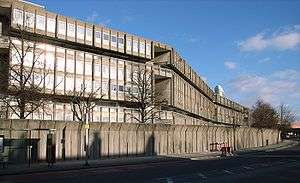 Robin Hood Gardens (1972) housing complex in Poplar, East London. Designed by the Smithsons.
Robin Hood Gardens (1972) housing complex in Poplar, East London. Designed by the Smithsons..jpg) Buffalo City Court Building (built 1971–1974) by Pfohl, Roberts, and Biggie, is a classic example of Brutalism's imposing aesthetic
Buffalo City Court Building (built 1971–1974) by Pfohl, Roberts, and Biggie, is a classic example of Brutalism's imposing aesthetic.jpg) The entry hall of High Court of Australia (1980) in Canberra
The entry hall of High Court of Australia (1980) in Canberra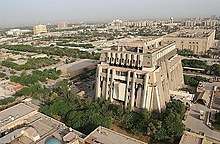 Al Zaqura Building, Baghdad (1975)
Al Zaqura Building, Baghdad (1975).jpg) Middle East Technical University Lecture Hall, Turkey (1961–1980)
Middle East Technical University Lecture Hall, Turkey (1961–1980).jpg) Middle East Technical University Rector Building, Turkey (1961–1980)
Middle East Technical University Rector Building, Turkey (1961–1980)- Wotruba Church in Vienna
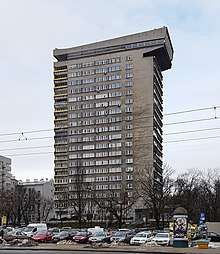 Młotek in Warsaw (1976)
Młotek in Warsaw (1976)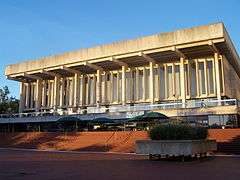 Perth Concert Hall, in Perth, Australia (1973)
Perth Concert Hall, in Perth, Australia (1973) Western City Gate (1979), Belgrade, Serbia
Western City Gate (1979), Belgrade, Serbia
See also
Notes
- "Definition of BRUTALISM". www.merriam-webster.com. Retrieved 11 July 2019.
- Bull, Alun (8 November 2013), What is Brutalism?, retrieved 10 October 2018
- Đorđe, Alfirević & Simonović Alfirević, Sanja: Brutalism in Serbian Architecture: Style or Necessity? Facta Universitatis: Architecture and Civil Engineering (Niš), Vol. 15, No. 3 (2017), pp. 317–331.
- Hopkins, Owen. "The Dezeen guide to Brutalist architecture". Dezeen. Retrieved 19 April 2020.
- Editorial Staff. "Brutalist architecture - a retrospective". Architecture and Design. Retrieved 19 April 2020.
- "Brutalist Architecture London | A Guide To Brutalism". 20 Bedford Way. 23 June 2014. Retrieved 11 May 2020.
- Harwood, Elain. "The concrete truth? Brutalism can be beautiful". BBC Arts. Retrieved 11 May 2020.
- Rasmus Wærn (2001). Guide till Sveriges Arkitektur : Byggnadskonst Under 1000 År. Stockholm: Arkitektur Förlag. ISBN 9789186050559.
- Hans Asplund's letter to Eric De Mare, Architectural Review, August 1956
- The New Brutalism, Reyner Banham, Architectural Press, London 1966, p10
- Review, Architectural (15 May 2014). "The New Brutalism". On Architecture. Retrieved 10 October 2018.
- Snyder, Michael. "The Unexpectedly Tropical History of Brutalism". The New York Times. Retrieved 11 May 2020.
- "A Movement in a Moment: Brutalism | Architecture | Agenda". Phaidon. Retrieved 11 May 2020.
- Plitt, Amy (11 November 2019). "The history of Brutalist architecture in NYC affordable housing". Curbed NY. Retrieved 30 April 2020.
- Hopkins, Owen. "The Dezeen guide to Brutalist architecture". Dezeen. Retrieved 19 April 2020.
- Byrnes, Mark. "The Case for Calling Brutalism 'Heroic' Instead". CityLab. Retrieved 1 June 2020.
- Meades, Jonathan (13 February 2014). "The incredible hulks: Jonathan Meades' A-Z of brutalism". the Guardian. Retrieved 10 October 2018.
- "Edman, Bengt (1921 - 2000)". digitaltmuseum.org. Retrieved 27 April 2020.
- VIDLER, ANTHONY. “Another Brick in the Wall.” October, vol. 136, 2011, pp. 105–132. JSTOR, https://www.jstor.org/stable/23014873
- Bull, Alun (8 November 2013), What is Brutalism?, retrieved 10 October 2018
- The New Brutalism, Reyner Banham, Architectural Press, London 1966, p19
- Brutalism: Post-War British Architecture, Alexander Clement, Second Edition, Chapter 3
- Johnson, Philip (19 August 1954). "School at Hunstanton, Norfolk, by Alison and Peter Smithson". Architectural Review. Retrieved 24 September 2019.
- McClelland, Michael, and Graeme Stewart, "Concrete Toronto: A Guide to Concrete Architecture from the Fifties to the Seventies," Coach House Books, 2007, p. 12.
- British Brutalism. World Monument Fund.
- "Historian of the Immediate Future: Reyner Banham - Book Review Art Bulletin, The - Find Articles". 30 August 2007. Archived from the original on 30 August 2007. Retrieved 4 July 2019.
- The New Brutalism, Reyner Banham, Architectural Press, London 1966 pp16
- Banham, Reyner (1966). The New Brutalism. London: Architectural Press. p. 41.
- Goodwin, Dario (22 June 2017). "Spotlight: Alison and Peter Smithson". www.archdaily.com.
- Heuvel, Dirk van den (4 March 2015). "Between Brutalists. The Banham Hypothesis and the Smithson Way of Life". The Journal of Architecture. 20 (2): 293–308. doi:10.1080/13602365.2015.1027721. ISSN 1360-2365.
- Rasmus Wærn (2001). Guide till Sveriges Arkitektur : Byggnadskonst Under 1000 År. Stockholm: Arkitektur Förlag. ISBN 9789186050559.
- Hans Ulrich Obrist, Smithson Time (Cologne,Verlag der Buch- handlung Walther König, 2004), p. 17
- A. and P. Smithson, ‘The “As Found” and the “Found”, in, D. Robbins, ed., The Independent Group, op. cit., p. 201.
- Published Letter, John Voelcker, Architectural Design, June 1957
- Davies, Colin (2017). A New History of Modern Architecture. London: Laurence King Publishing. p. 277. ISBN 978-1-78627-056-6.
- Dutton, John (26 July 2013). "Featured Plan: Smithsons' Golden Lane Project (1952) - GRIDS blog". GRIDS blog. USC School of Architecture. Retrieved 11 November 2017.
- Kulić, Vladimir; Mrduljaš, Maroje; Thaler, Wolfgang (2012). Modernism In-Between: The Mediatory Architectures of Socialist Yugoslavia. Berlin: Jovis. ISBN 978-3-86859-147-7.
- Jordy, William (1972). The Impact of European Modernism in the Mid-twentieth Century. American Buildings and Their Architects. 5. New York, Oxford: Oxford University Press. p. 363. ISBN 0-19-504219-0.
- Farrelly, Elizabeth (9 October 2010). "Watch this space – Brutalism meets beauty in the National Gallery's new wing". The Sydney Morning Herald, Spectrum supplement. pp. 16–17.
- Paiement, Genevieve: Habitat 67, Montreal's 'failed dream' – a history of cities in 50 buildings, day 35. The Guardian, 13 May 2015. Retrieved 3 June 2017.
- "Architects: Brutalism". Circa Design.
- Trounstine, Philip J. (9 May 1976). "Evans Woollen". [Indianapolis] Star Magazine. Indianapolis, Indiana: 18. See also: "Prominent local architect Woollen Dies at 88". Indianapolis Business Journal. Indianapolis. 19 May 2016. Retrieved 18 December 2017.
- Vittoriano Viganò. A come Asimmetria. Gangemi Editore spa. 2011. p. 124. ISBN 978-88-492-6584-2.
- "Centar za stanovanje – Center for Housing". stanovanje.yolasite.com. Retrieved 14 July 2017.
- "Centar za stanovanje – Center for Housing". stanovanje.yolasite.com. Retrieved 14 July 2017.
- "Genex Tower, Belgrade". EMPORIS. Retrieved 22 July 2017.
- Daliborka Mučibabić (8 May 2019). "Архитекте траже заштиту Западне капије" [Architects ask for the protection of the Western Gate]. Politika (in Serbian). p. 15.
- Historic Netsch Campus at UIC Retrieved 31 December 2010
- Megan Fernandez (June 2010). "The Pillar: Evans Woollen". Indianapolis Monthly. Indianapolis, Indiana: 68. Retrieved 18 December 2017. See also: Philip J. Trounstine (9 May 1976). "Evans Woollen: Struggles of a 'Good Architect'". [Indianapolis] Star Magazine. Indianapolis, Indiana: 23.
- Millett, Larry (2007). AIA Guide to the Twin Cities. Saint Paul, Minnesota: Minnesota Historical Society. p. 148.
- Kopelk, William (2005). E. Stewart Williams: A Tribute to His Work and Life. Palm Springs, CA: Palm Springs Preservation Foundation.
- "Thomas H. Eliot Hall". Washington University in St. Louis. Retrieved 25 February 2020.
- Marina Warner. "Diary: Why I Quit". London Review of Books.
- "Nasty, brutish and tall - Architecture". The Economist. 29 August 2014. Retrieved 13 August 2019.
- "CIP 25 - Corrosion of Steel in Concrete" (PDF). nrmca. National Ready Mixed Concrete Association. Retrieved 7 May 2017.
- Winston, Anna: Five architectural treasures we must save from the UK’s heritage war. The Guardian, 18 June 2015.
- "Archived copy". Archived from the original on 22 November 2016. Retrieved 22 September 2016.CS1 maint: archived copy as title (link) CS1 maint: BOT: original-url status unknown (link)
- Theodore Dalrymple (Autumn 2009). "The Architect as Totalitarian". City Journal. Retrieved 4 January 2010.
- Griffin, Andrew (14 June 2017). "Grenfell Tower cladding that may have led to fire was chosen to improve appearance of Kensington block of flats". The Independent. Retrieved 20 June 2017.
- "Villa Göth". www.lansstyrelsen.se (in Swedish). Retrieved 23 April 2020.
- "Historical Resources Inventory: Buildings and Structures: The Pirelli Building, New Haven" (PDF). Connecticut Historical Commission. Retrieved 24 September 2019.
- English Heritage Images of England.
References
- Golan, Romy: Historian of the Immediate Future: Reyner Banham – Book Review. The Art Bulletin, June 2003. (Retrieved 29 December 2014.)
- Monzo, Luigi: Plädoyer für herbe Schönheiten. Gastbeitrag im Rahmen der Austellung "SOS Brutalismus – Rettet die Betonmonster". Pforzheimer Zeitung, 27. February 2018, p. 6. (in German)
- Anna Rita Emili, Pure and simple, the architecture of New Brutalism, Ed.Kappa Rome 2008
- Anna Rita Emili, Architettura estrema, il Neobrutalismo alla prova della contemporaneità, Quodlibet, Macerata 2011
Further reading
- Highmore, Ben (2017). The Art of Brutalism: Rescuing Hope from Catastrophe in 1950s Britain. New Haven: Yale University Press. ISBN 978-0-300-22274-6.
- Kapur, Akash (October 18, 2018). "Can Poland's Faded Brutalist Architecture Be Redeemed?". The New York Times. ISSN 0362-4331.
External links
| Wikimedia Commons has media related to Brutalist architecture. |
- "The incredible hulks: Jonathan Meades' A-Z of Brutalism"
- Ontario Architecture: Brutalism
- "10 Iconic Brutalist Buildings in Latin America"
